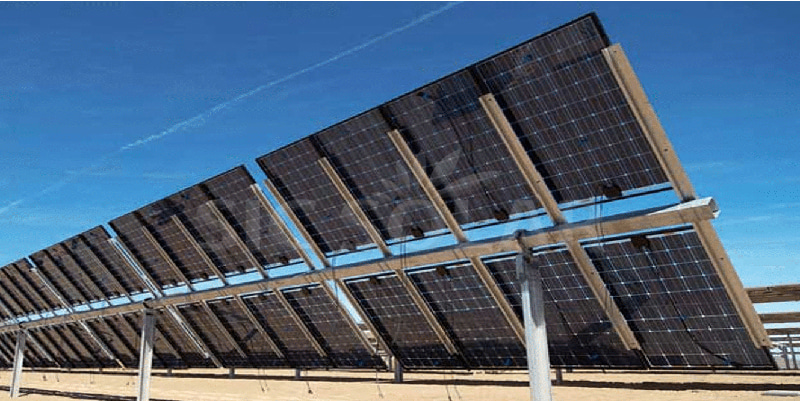Bifacial solar panels have gained popularity in the solar industry due to their ability to capture sunlight on both sides of the panel, leading to higher energy yields compared to traditional monofacial panels. However, to fully capitalize on the benefits of bifacial panels, careful consideration must be given to the design and integration of the solar mounting systems. Here are the key factors to consider when integrating solar mounting systems with bifacial solar panels.
1. Optimizing Panel Tilt and Orientation
Why It’s Important: The tilt and orientation of bifacial solar panels significantly influence their energy output. Unlike monofacial panels, which primarily generate power from direct sunlight on the front side, bifacial panels also harness reflected and diffuse light from the back side.
Consideration: The tilt angle of the panels should be optimized to maximize both direct and reflected sunlight. A steeper tilt angle may enhance the capture of sunlight on the rear side by allowing more light to reach the underside of the panel. Similarly, the orientation of the panels should be aligned to maximize exposure to sunlight throughout the day.
SIC Solar Role: SIC Solar designs mounting systems that allow for adjustable tilt angles and orientations, enabling installers to fine-tune the positioning of bifacial panels for optimal energy generation.
2. Selecting the Right Ground Surface and Albedo
Why It’s Important: The surface beneath bifacial solar panels, known as the albedo, plays a critical role in their performance. Albedo refers to the reflectivity of the surface, which determines how much light is reflected onto the rear side of the panels.
Consideration: Surfaces with high albedo, such as white gravel, light-colored concrete, or even snow, reflect more light and enhance the energy yield of bifacial panels. In contrast, dark or non-reflective surfaces, such as asphalt, may reduce the effectiveness of the rear-side generation.
SIC Solar Role: SIC Solar mounting systems can be tailored to different site conditions, ensuring that the system design maximizes the albedo effect for bifacial panels.
3. Height and Spacing of Mounting Structures
Why It’s Important: The height at which bifacial panels are mounted and the spacing between rows affect the amount of reflected light reaching the rear side. Proper height and spacing also ensure adequate airflow, which helps in maintaining panel efficiency by reducing heat buildup.
Consideration: Bifacial panels should be mounted at a sufficient height above the ground to allow for more light to be reflected onto the rear side. The spacing between rows should be optimized to minimize shading from adjacent rows while maximizing ground reflection.
SIC Solar Role: SIC Solar offers mounting solutions with customizable heights and spacing options, designed to enhance the performance of bifacial panels by optimizing their exposure to reflected light.
4. Minimizing Shading and Obstructions
Why It’s Important: Shading on bifacial panels, particularly on the rear side, can significantly reduce their overall energy output. Unlike monofacial panels, where shading primarily affects the front side, bifacial panels require careful consideration of shading on both sides.
Consideration: The design of the mounting system should aim to minimize any shading from structural elements, such as mounting rails or support beams, which could block sunlight from reaching the rear side of the panels. Additionally, the site layout should be planned to avoid shadows cast by nearby objects, such as trees, buildings, or other rows of panels.
SIC Solar Role: SIC Solar mounting systems are engineered to minimize shading by using narrow support structures and strategically placed components that do not obstruct the rear side of the panels.
5. Material Selection for Mounting Systems
Why It’s Important: The materials used in the mounting system can impact the performance of bifacial panels. Certain materials may cast shadows or reduce the reflectivity of light, thereby decreasing the energy yield of the rear side of the panels.
Consideration: Mounting systems for bifacial panels should be made from materials that are durable, corrosion-resistant, and have a low shading profile. Transparent or light-colored materials can help in enhancing reflectivity, while avoiding materials that may obstruct light from reaching the rear side.
SIC Solar Role: SIC Solar uses high-quality, corrosion-resistant materials in their mounting systems, designed to support the specific needs of bifacial panels while minimizing any negative impact on their performance.
6. Electrical Considerations and Wiring Management
Why It’s Important: The electrical design and wiring layout can affect the efficiency and aesthetics of a bifacial solar installation. Proper management of cables and electrical components is essential to avoid shading and ensure optimal performance.
Consideration: Wiring should be carefully routed and managed to avoid shading on the rear side of the panels. This includes minimizing the use of junction boxes or other electrical components that could block sunlight. Additionally, the electrical design should account for the potential higher energy yield from bifacial panels, ensuring that inverters and other system components are appropriately sized.
SIC Solar Role: SIC Solar provides mounting systems with integrated cable management solutions, designed to keep wiring organized and out of the way, reducing the risk of shading and maintaining a clean installation appearance.

Integrating solar mounting systems with bifacial solar panels requires careful consideration of various factors, including panel tilt, surface reflectivity, mounting height, shading, material selection, and electrical design. By addressing these considerations, you can maximize the energy generation potential of bifacial panels and ensure a successful solar installation.
SIC Solar expertise in designing and manufacturing mounting systems tailored to the needs of bifacial panels makes them a valuable partner in optimizing your solar project. With the right mounting system, you can fully harness the advantages of bifacial solar technology, achieving higher energy yields and greater return on investment.